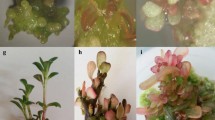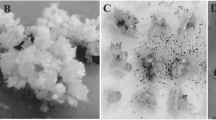Abstract
Transgenic plants of an Indian isolate of Lemna minor have been developed for the first time using Agrobacterium tumefaciens and hard nodular cell masses ‘nodular calli’ developed on the BAP - pretreated daughter frond explants in B5 medium containing sucrose (1.0 %) with 2,4-D (5.0 μM) and 2-iP (50.0 μM) or 2,4-D (50.0 μM) and TDZ (5.0 μM) under light conditions. These calli were co-cultured with A. tumefaciens strain EHA105 harboring a binary vector that contained genes for β-glucuronidase with intron and neomycin phosphortransferase. Transformed cells selected on kanamycin selection medium were regenerated into fronds whose transgenic nature was confirmed by histochemical assay for GUS activity, PCR analysis and Southern hybridization. The frequency of transformation obtained was 3.8 % and a period of 11–13 weeks was required from initiation of cultures from explants to fully grown transgenic fronds. The pretreatment of daughter fronds with BAP, use of non-ionic surfactant, presence of acetosyringone in co-cultivation medium, co-culture duration of 3 d and 16 h photoperiod during culture were found crucial for callus induction, frond regeneration and transformation of L. minor. This transformation system can be used for the production of pharmaceutically important protein and in bioremediation.




Similar content being viewed by others
Abbreviations
- 2,4-D:
-
2,4-dichlorophenoxyacetic acid
- 2-iP:
-
6-(-γ,-γ-dimethyl allyl amino) purine
- BAP:
-
6-benzylaminopurine
- IAA:
-
Indole-3-acetic acid
- Kin:
-
Kinetin
- TDZ:
-
Thidiazuron
- CaMV:
-
Cauliflower mosaic virus
References
Bog M, Baumbach H, Schween U, Hellwig F, Landolt E, Appenroth KJ (2010) Genetic structure of the genus Lemna L. (Lemnaceae) as revealed by amplified fragment length polymorphism. Planta 232:609–619
Brain RA, Solomon KR (2007) A protocol for conducting 7-day daily renewal tests with Lemna gibba. Nat Prot 2:979–987
Brunning JL, Kintz BL (1977) Computational hand book of statistics, 2nd edn. Scott Foresman, Glenview
Cabrera LI, Salazar GA, Chase MW, Mayo SJ, Bogner J, Davila P (2008) Phylogenetic relationships of aroids and duckweeds (Araceae) inferred from coding and noncoding plastid DNA. Am J Bot 95:1153–1165
Cheng JJ, Stomp AM (2009) Growing duckweed to recover nutrients from wastewaters and for production of fuel ethanol and animal feed. Clean 37:17–26
Cheng M, Fry JE, Pang S, Zhou H, Hironaka CM, Duncan DR, Conner TW, Wan Y (1997) Genetic transformation of wheat mediated by Agrobacterium tumefaciens. Plant Physiol 115:971–980
Chhabra G, Singh RP, Jaiwal PK (2007) Duckweed biotechnology for commercial exploitation. Physiol Mol Biol Plant 13:1–7
Chung MH, Chen MK, Pan SM (2000) Floral spray transformation can efficiently generate Arabidopsis transgenic plants. Transgen Res 9:471–476
Cox KM, Sterling JD, Regan JT, Gasdaska JR, Frantz KK, Peele CG, Black A, Passmore D, Moldovan-Loomis C, Srinivasan M, Cuison S, Cardarelli PM, Dickey LF (2006) Glycan optimization of a human monoclonal antibody in the aquatic plant Lemna minor. Nat Biotech 24:1591–1597
Gamborg OL, Miller RA, Ojima K (1968) Nutrient requirements of suspension cultures of soybean root cells. Exp Cell Res 50:151–156
Hagner M, Penttinen O, Pasanen T, Tiilikkala K, Setala H (2010) Acute toxicity of birch tar oil on aquatic organisms. Agri Food Sci 19:24–33
Haustein AT, Gilman RH, Skillicorn PW, Ventura G (1987) Safety and efficacy of sewage grown Lemna as a protein source for chickens. Sunny Spring, Columbia
Jefferson RA, Kavanagh TA, Beven MW (1987) GUS fusions: betaglucuronidase as a sensitive and versatile gene fusion marker in higher plants. EMBO J 6:3901–3907
Khellaf N, Zerdaoui M (2009) Growth response of the duckweed Lemna minor to heavy metal pollution. Iran J Environ Health Sci Engg 6:161–166
Kim MJ, Baek K, Park CM (2009) Optimization of conditions for transient Agrobacterium-mediated gene expression assays in Arabidopsis. Plant Cell Rep 28:1159–1167
Kruse C, Boehm R, Voeste D (2002) Transient transformation of Wolffia columbiana by particle bombardment. Aquat Bot 72:175–181
Landolt E (1986) The family of Lemnaceae—a monographic study. Vol 1 Veröffentlichungen des Geobotanischen Institutes der ETH, Stiftung Rübel (Zürich) 71:1–566
Leblebici Z, Aksoy A (2010) Growth and lead accumulation capacity of Lemna minor and Spirodela polyrhiza (Lemnaceae): Interactions with nutrient enrichment. Water Air Soil Poll. (published online) doi:10.1007/s11270-010-0413-1
Les DH, Crawford DJ, Landolt E, Gabel JD, Kimbell RT (2002) Phylogeny and systematics of Lemnaceae, the duckweed family. Syst Bot 27:221–240
Li J, Jain M, Vunsh R, Vishnevetsky J, Hanania U, Flaishman M, Perl A, Edelman M (2004) Callus induction and regeneration in Spirodela and Lemna. Plant Cell Rep 22:457–464
Men BX, Ogle RB, Preston TR (1995) Use of duckweed (Lemna spp.) as replacement for soybean meal in as basal diet of broken rice for fattening ducks. Livest Res Rur Dev 7:5–8
Men LT, Van BH, Chinh MT, Preston TR (1997) Effect of dietary protein level and duckweed (Lemna spp.) on reproductive performance of pigs fed a diet of ensiled cassava root or cassava root meal. Livest Res Rur Dev 9:1–5
OECD guidelines for the testing of chemicals (2002) Lemna sp. Growth inhibition test. Organization for Economic Cooperation and Development, Berlin, p 22
Porath D (1993) Aquaculture production of duckweeds for human consumption. United States Kibbutz, Tzora (IL) 5269819. www.freepatentsonline.com/5269819.html accessed on August 17, 2010
Roger SO, Bendich AJ (1988) Extraction of DNA from plant tissues. In: Gelvin SB, Schilperoot RA (eds) Plant molecular biology manual. Kluwer, Dordrecht, pp 1–11
Saini R, Jaiwal PK (2007) Agrobacterium tumefaciens—mediated transformation of blackgram: an assessment of factors influencing the efficiency of uidA gene transfer. Biol Plant 51:69–79
Sambrook J, Fritsch EF, Maniatis T (1989) Molecular cloning: a laboratory manual. Cold Spring Harbor Laboratory, New York
Skillicorn P, Spira W, Journey W (1993) Duckweed aquaculture—a new aquatic farming system for develo** countries. The World Bank, Washington D.C., p 76
Wu H, Sparks C, Amoah B, Jones HD (2003) Factors influencing successful Agrobacterium-mediated genetic transformation of wheat. Plant Cell Rep 21:659–668
Yamamoto YT, Rajbhandari N, Lin X, Bergmann BA, Nishimura Y, Stomp AM (2001) Genetic transformation of duckweed Lemna gibba and Lemna minor. In Vitro Cell Dev Biol Plant 37:349–353
Yilmaz E, Akyurt I, Gunal G (2005) Use of duckweed, Lemna minor, as a protein feedstuff in practical diets for common carp, Cyprinus carpio. Fry Turk J Fish Aquat Sci 4:105–109
Acknowledgements
GKC thanks to Council of Scientific and Industrial Research (CSIR), New Delhi, India for providing financial support. We are also thankful to Dr. Richard Jefferson, Center for Application of Molecular Biology to International Agriculture (CAMBIA), Australia, for providing the plasmid pCAMBIA2301.
Author information
Authors and Affiliations
Corresponding author
Rights and permissions
About this article
Cite this article
Chhabra, G., Chaudhary, D., Sainger, M. et al. Genetic transformation of Indian isolate of Lemna minor mediated by Agrobacterium tumefaciens and recovery of transgenic plants. Physiol Mol Biol Plants 17, 129–136 (2011). https://doi.org/10.1007/s12298-011-0059-5
Published:
Issue Date:
DOI: https://doi.org/10.1007/s12298-011-0059-5




